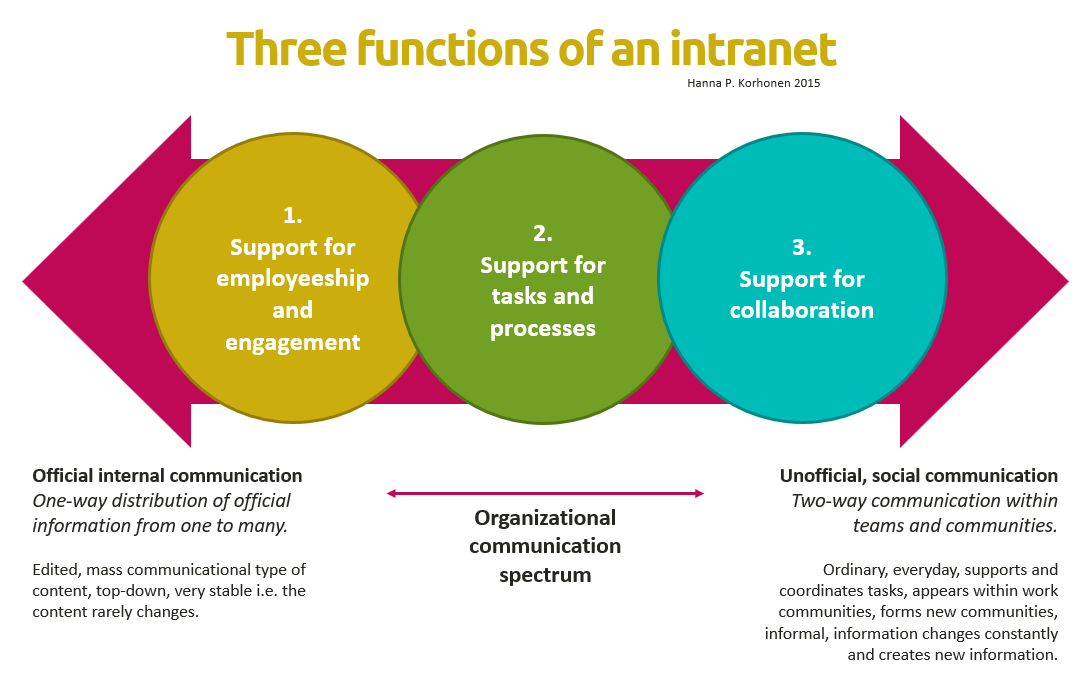Intranet is a service which essentially exists due to the information it contains. However, not all information is relevant for every user group. On the other hand, some of this information is relevant for everyone – oftentimes it is even “pushed” in front of everybody’s eyes. Then again, some of the content is utilized actively every day – and some of it only once a year. Moreover, keeping the content up to date should be super-easy.Challenging requirements for intranet concept planning? Three-function framework for intranet content strategy provides a helpful tool for content planning and managing the explicit organizational information inside an intranet – or a digital workplace.
North Patrol is a consulting firm specialized in the design of digital services and information systems. We shape ideas into a vision and service concept, find the best architectural and technological solutions, design a functional user experience, and compete to find the ideal partner for implementation work. We do not sell implementation projects, nor do we sell licenses; we are genuinely on the side of the customer.

Three functions of an intranet framework
Today, the intranets are no longer just “internal websites” with static content in hierarchical content structures. They are digital workplaces with several applications.
The three functions of an intranet framework helps to identify the most significant intranet use cases, the content types related to them, and the functionalities that enable them.
The framework helps to outline the components of the entity formed by the intranet and the digital workplace in general, and assign roles to these components in relation to each other.
This way, the framework assists in implementing the roles of each intranet / digital workplace component, facilitates internal communications, and supports expectations management.
The framework can also be used for setting up a digital workplace ecosystem, such as assigning roles to applications in an Office 365 environment.
Extreme ends of the organizational communication spectrum
What lies underneath the framework is the placement of functions within the organizational communication context, which ranges within the following scale:
A. Official internal communication
Official internal communications refers to one-way company-wide distribution of official information from one to many that is characterized with: edited, mass communicational type of content, provided one-to-many, most probably top-down, very stable i.e. the content rarely changes.
Some concrete examples would be code of conduct, company guidelines, official internal bulletins, and articles written by the top management.
B. Unofficial, social communication
On the other side of the spectrum lies unofficial, social communication that refers often to two-way communication within teams and communities. Its characteristics are: Ordinary, everyday, informal, appears within work communities, forms communities, supports work tasks, information changes constantly.
Concrete examples: working in projects, coordination of work, active exchange of ideas between experts within the same organization, and interactions of sales personnel in the company-internal social media.
An intranet or digital workplace may be used to support organizational communication, interaction, and conveying information in all contexts within the communication spectrum defined above.
(Note: Intranets are not platforms for one-to-one communications.)
Framework elements
The three framework elements placed on the organizational communication spectrum can be used to identify types of information and communication needed on the intranet and to help planning the roles for the applications and data repositories on the digital workplace.
The three elements starting from the official company-wide internal information and moving to social team communication are:
1. Support for employeeship and engagement
These content types and functionalities are the core of an intranet. Each piece of content remains the same for every employee.
These types of content have been produced “by the few, for the masses”; they are officially approved. They include guidelines and instructions from the employer for the employee, such as HR guidelines or an organizational structure chart, links to tools and systems, internal and strategic communication, as well as information regarding company-internal services, support functions, and related instructions.
Even though the content is intended for the whole personnel, several language versions may exist. Furthermore, information may exist for each office or locale.
This function can be found in every intranet. These are such fundamental building blocks of an intranet, that one could almost copy this type of common content from an another organisation!
It is possible that this is the only function of the intranet, especially in production-intensive organizations where content that supports employeeship needs to be accessible for both knowledge workers and blue-collar production personnel, whereas knowledge work tools are only needed by the white-collar workers.
2. Support for job tasks and processes
This is the most fascinating part of designing an intranet concept, the element which makes intranets so unique to their organization. If an intranet is made to support business processes, we are talking about a business critical intranet.
Not all intranets have this function at all.
Job task support entails guidelines and support materials for each (or typically for some of the most important) process or role within the organization. In a larger scale, this means: how do we apply our strategy for this particular process/role? This kind of content is only relevant for persons working in the process/role in question.
It is created and approved on process-basis. But since this content lies between the extreme ends of the organizational communication spectrum described above, some of the content is more official (such as policies, guidelines and process documentation maintained by using a certain, explicitly defined process) and some of it is more informal (such as discussions by the personnel on how to apply the guidelines in practice, learn from others in the process’s context and to get peer support).
3. Support for collaboration
A part of communication is specific to a work team, such as work within workgroups, teams, communities, and projects, and even units or offices.
For knowledge workers, this may be manifested as a shared groupwork space/site, which may also be a place for keeping and editing shared documents related to their work.
On the other hand, one manifestation could be a company-internal social media channel, enterprise social network (ESN). ESNs are very useful for coordination of everyday work activities of a store, for instance, as well as acting as online platforms for communities of practices.
This type of content is created by the community itself, and it is edited in a plain and practical manner. Typically, one person is related to more than one community or team.
This function does not necessarily appear in an intranet, either. For example, in an organization with heavy emphasis on production, the service that they call “the intranet” may only serve function #1 described above, a second platform (e.g. Microsoft Office 365, Google G Suite, IBM Connections, Atlassian Confluence) exists to serve the needs of document-intensive teamwork of knowledge workers, and a third platform (ESN platform e.g. Yammer, Facebook for Work) serves the interaction needs of production workers.
So, to be able to piece together the big picture, and to provide content in a way that it is easy to find, it is extremely important to recognize the functions of the intranet within your organization, and to assign roles for tools to support these functions.
Where to begin?
Do this: Using the three functions of an intranet framework in content structure planning:
- Identify the organization’s business and support processes and the people involved in them.
- Identify what kind of information is transferred (or should be transferred) within these processes, and to enable these processes. Use e.g. interviews and workshops.
- Identify who uses and produces the information in the processes. Analyze the types and nature of information: the degree of formality vs informality.
- Based on the framework, define: What or what type of information transfer can be supported by the intranet? Which roles does the intranet have in your organization?
A. Communicational, informative, and community-building; and/or
B. Business-supporting, managing and controlling; and/or
C. Teamwork or team communications tool - The three functions of an intranet framework contains these three main roles, and they are used to define a clear-cut concept for the intranet. By applying the framework, each digital workplace application is assigned a role which indicates the purpose of use which supports the defined goals and targets, and each piece of content is assigned a role which indicates the thematically organized entity and content type which, likewise, supports the defined goals and targets.
Remember: If the intranet is also used for supporting a business, this particular business has to participate actively in planning and managing the intranet (as well as continuous development!).
Note: In addition to the technical requirements specification, the content structure plan is used to support the intranet implementation project.

